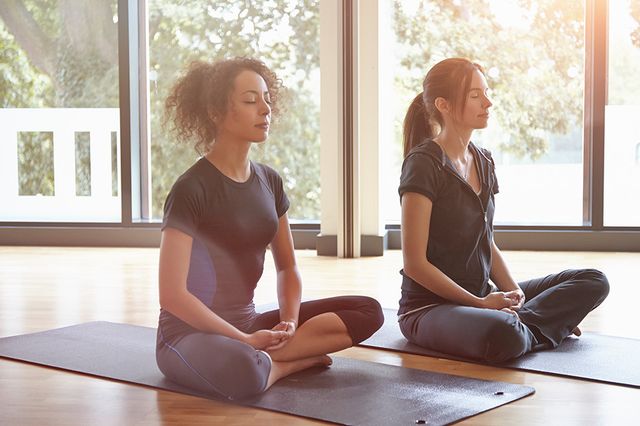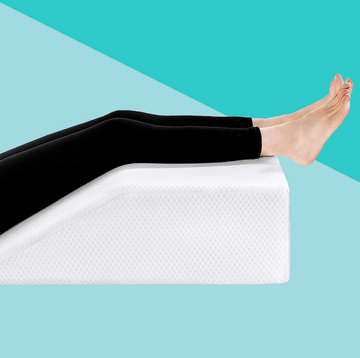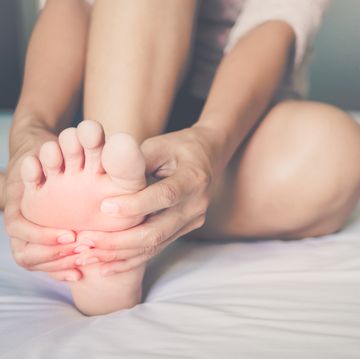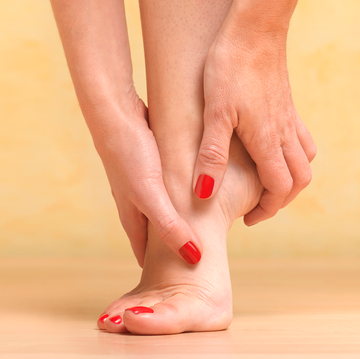Chronic pain in America is big business—$560 to $635 billion, according to the American Academy of Pain Medicine. An estimated 100 million Americans suffer to varying degrees, and many of them are desperate for relief.
While pain-relieving medication often helps, there are serious side effects to consider, it doesn't work well for everyone, and some people just prefer to go a more natural route. Might yoga fit the bill?
MORE: This Exercise Helped Me Finally Manage My Chronic Pain
Recently, I came across an online course by Spirit Voyage that claims to help heal chronic pain through Kundalini yoga (a dynamic form of yoga) and the power of the mind, and I admit I was skeptical. I knew that a regular yoga practice can help you touch your toes (or at least, get a little closer) and help you keep your cool in stressful situations (or at least, stay a little calmer). But could yoga really make a difference for people with serious pain issues? (Could you be stressed and not know it? Here are 10 silent signals you're way too stressed out.)
My initial reaction was a big, fat no. So I started to do some digging, and it turns out, I was wrong. A growing body of evidence shows that yoga really can help ease chronic pain, not to mention play a role in preventing a myriad of other serious health problems. Here’s what I learned.
(Discover the ONE simple, natural solution that can help you reverse chronic inflammation and heal more than 45 diseases. Try The Whole Body Cure today!)
What the science says
More and more, research suggests that yoga can play a role in relieving chronic pain. Among people with lower back issues, for instance, those who practiced yoga for six months reported significantly less disability, pain, and depression compared to patients who only underwent standard treatment.
Other studies have shown that yoga is effective for fibromyalgia pain. Meanwhile, the practice has been shown to ease joint pain and improve functioning in those with arthritis. One study even suggests that yoga could be helpful for headaches.
MORE: 6 Stretches To Ease Fibromyalgia Pain
Granted, many of these studies have been small or considered preliminary, but there certainly seems to be good reason to believe that yoga can make a difference for people in pain. That’s not to say that hanging out in warrior 2 or tree pose alone will make all your aches instantly disappear. Just as spending time on the mat can't substitute the antibiotics your doctor prescribes to treat an infection, “yoga shouldn’t be viewed as a replacement for conventional medical treatment,” says Chris Gilbert, MD, integrative physician and author of The Listening Cure. But adopting a regular practice might enable you to take lower doses of pain medication or get off of it sooner than expected. And for people who find that no medication seems to touch their pain, adding yoga to the mix might help them finally get relief. (If you're fighting pain all the time, you may want to try one of these 12 odd pain relief tricks that actually work.)
MORE: 9 Thoughtful Gifts For Someone With Chronic Pain
How yoga helps
What is it about hanging out in downward-facing dog or savasana that seems to be so powerful? In large part, it comes down to yoga’s ability to reduce stress. “This strengthens the immune system, making it better able to fight infection and reduce inflammation,” says Gilbert. And since pain and inflammation often go hand-in-hand, less inflammation usually means you'll feel better, whether it's your knees, back, or hips that have been aching.
Another important factor is that people who are less stressed are less apt to overeat, which can help with weight maintenance or loss. That's especially important if you have a painful condition like arthritis, since being overweight puts excess stress on weight-bearing joints like your knees.
If you're over 40, you must do these 6 things to lose weight:
Also key: Yoga keeps you moving. One of the biggest factors determining whether a person with back or joint pain will regain their functioning is whether they remain physically active, says Roger Allen, PhD, PT, distinguished professor of physical therapy at the University of Puget Sound. Even though it might be uncomfortable, movement can actually help injuries heal. “In physical therapy, we try to restore and normalize physical activity once it’s safe to do so, so someone isn’t favoring one limb,” for example, he says. “Yoga can serve a really useful role with this.”
It can also make discomfort seem like less of a big deal, too. Though it might sound a little woo-woo, pain has an emotional component. “The awareness of the sensation of pain and the suffering we experience are separate neurological events,” Allen says. “But in our conscious mind, we wrap those things together as a singular experience.” By emphasizing mindfulness, yoga is one way that people with chronic pain can learn to dissociate physical pain from its emotional counterpart—and as a result, experience less suffering, explains Anne Novak, RYT, a KRI-certified Kundalini yoga instructor and the teacher of Spirit Voyage’s online course. (Psychotherapy is another tool that can help.) In fact, findings published in Cerebal Cortex suggest that yoga actually leads to structural changes in the brain related to pain processing and regulation.
MORE: This 9-Minute Yoga Routine Will Help You Ditch Lower-Back Pain
A few caveats
All of this sounds impressive, but some caution is still in order. Yes, yoga helps a lot of people, but it's not for everyone, and it might not be a suitable replacement for physical therapy. And if you have an active lesion or wound, spinal instability, or a joint that could be harmed by excessive movement, yoga could end up making the problem worse, says Allen.
If you’re thinking about starting a yoga practice, treat it like any other form of exercise and get your doctor’s OK first, recommend Allen and Gilbert. Your doctor should confirm that you’re fit enough to try a class without putting yourself at risk. And if you’re dealing with an injury, she can let you know whether the problem has healed to the point where yoga would be safe.
MORE: The 10-Minute Gentle Yoga Routine That Can Help You Lose Weight
You should also make an effort to find the right teacher. “There are a lot of really skilled yoga instructors, but it’s a rare one who has the knowledge to avoid potential harm,” says Allen. It might help to seek out a class that's designed to meet your specific needs, such as yoga for back pain. Or, says Tiffany Cruikshank, a yoga, meditation, and wellness expert and founder of Yoga Medicine, consider hiring a private instructor. “If you have injuries or medical issues that need to be addressed, it's best to work one-on-one with a teacher who understands your needs,” she says.














